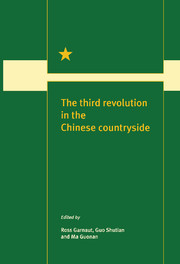Book contents
- Frontmatter
- Contents
- Figures
- Maps
- Tables
- Contributors
- Preface
- 1 The third revolution
- Feeding the people
- Marketing and price reform
- 6 Price reform for agricultural products
- 7 Grain marketing: from plan to market
- 8 Fertiliser price
- 9 Agricultural wholesale markets
- 10 The ‘wool war’ and the ‘cotton chaos’: fibre marketing
- 11 Conflict over cabbages: the reform of wholesale marketing
- Internationalisation
- Regional issues
- Institutional change
- References
- Index
8 - Fertiliser price
from Marketing and price reform
Published online by Cambridge University Press: 04 August 2010
- Frontmatter
- Contents
- Figures
- Maps
- Tables
- Contributors
- Preface
- 1 The third revolution
- Feeding the people
- Marketing and price reform
- 6 Price reform for agricultural products
- 7 Grain marketing: from plan to market
- 8 Fertiliser price
- 9 Agricultural wholesale markets
- 10 The ‘wool war’ and the ‘cotton chaos’: fibre marketing
- 11 Conflict over cabbages: the reform of wholesale marketing
- Internationalisation
- Regional issues
- Institutional change
- References
- Index
Summary
Between one-third and one-half of the increase in world grain production is attributed to the increased use of fertiliser in recent decades. In China, as elsewhere, agricultural development is closely related to the increase in the application of fertiliser. China's large population and limited arable land causes increases in the supply of agricultural products to depend on increasing yields, and gives fertiliser an important role in expanding supply. The price of fertiliser is a key variable affecting fertilisation use and agricultural yields, also having an important influence on farmers' incomes.
China's fertiliser price system
Before economic reform, China's chemical fertiliser prices were determined in the planned economy. Central government plans for agriculture were passed down to local governments. All agricultural products, except those that were retained as inputs into agricultural production or for peasants' consumption, were purchased by the government at fixed prices. At the same time, most materials needed in agricultural production, such as fertiliser, pesticides, diesel and high quality seeds and stock, were provided to peasants by the government at fixed prices through designated commercial networks.
In the 1950s the state transferred most of the surplus value created in agriculture, to industry, to provide capital for industrialisation. This was effected through the state purchasing agricultural products at lower prices than would have been available in a free market, and selling industrial products to the peasants at artificially high prices. This represented a hidden income redistribution.
- Type
- Chapter
- Information
- The Third Revolution in the Chinese Countryside , pp. 100 - 112Publisher: Cambridge University PressPrint publication year: 1996



